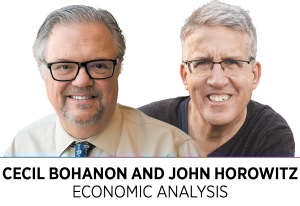Subscriber Benefit
As a subscriber you can listen to articles at work, in the car, or while you work out. Subscribe Now The Federal Reserve is designed to be an independent agency, not beholden to the fiscal impulses of Congress or the executive branch. It has a tremendous responsibility to stabilize the value of the U.S. dollar. A stable dollar is in the interest of citizens of the United States. Also, since the dollar is still the world’s premier reserve currency, its stability is central to a prosperous world economy. We have long advocated that the Fed firmly support its target 2% rate for U.S. inflation.
The Federal Reserve is designed to be an independent agency, not beholden to the fiscal impulses of Congress or the executive branch. It has a tremendous responsibility to stabilize the value of the U.S. dollar. A stable dollar is in the interest of citizens of the United States. Also, since the dollar is still the world’s premier reserve currency, its stability is central to a prosperous world economy. We have long advocated that the Fed firmly support its target 2% rate for U.S. inflation.
The U.S. inflation rate began rising well above the 2% benchmark in the spring of 2021 and continued to rise to a peak of 9.1% in June 2022. The Fed then accelerated its increases of interest rates to a peak of 5.5% in July 2023. The inflation rate declined but remained stubbornly above 3% until this July, when it finally dropped below 3%.
The Fed surmised that inflation had cooled enough to lower interest rates by half a percentage point in mid-September and a quarter point just after the November election. The Fed’s interest rate now stands at 4.75%.
But is inflation really tamed to the 2% benchmark? And what should the Fed do next? Our favorite indicator of future inflation is the St. Louis Federal Reserve’s 5-Year Breakeven Inflation Rate. Its inflation prediction is derived from calculating the difference in yields between inflation-indexed five-year U.S. bonds and unindexed five-year U.S. bonds. When the Fed chose not to decrease the interest rate at the end of July, the inflation-expectations measure dropped from 2.13% to 1.89% in two days—a market signal suggesting inflation had been tamed. Inflation expectations stayed below 2.02% until the day after the mid-September half-point cut. As of this writing, they have edged up to 2.39%.
Why did inflation expectations rise after the cuts? Although monetary policy is designed to be insulated from political pressures, fiscal policy—which is government taxing and spending—also affects economic outcomes. The executive and legislative branches both usually want the Federal Reserve to print the money to finance their schemes, no matter how foolish.
Since neither political party was (or is) paying much attention to the unprecedented fiscal imbalance our government faces, it is unsurprising that markets are expecting inflation. We believe there should be no more rate cuts until inflation has definitively declined. The inflation beast must be tamed.•
__________
Bohanon and Horowitz are professors of economics at Ball State University. Send comments to ibjedit@ibj.com.
Please enable JavaScript to view this content.
